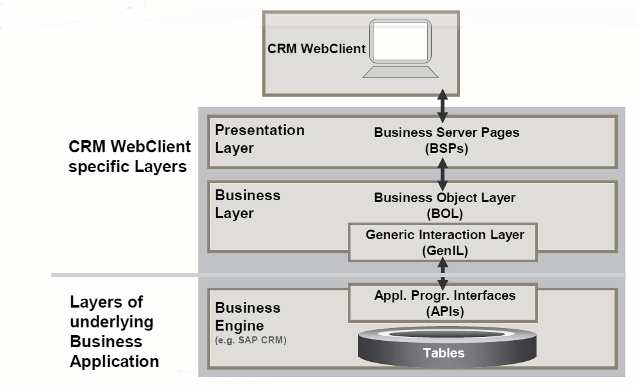There are different software layers in the framework architecture of SAP CRM. The thing with these software layers is that they are all separated from each other. The reason for this separation is to facilitate the connection of various business applications. In fact, these connections are made possible via generic interaction layer (genIL) and business object layer (BOL) to the CRM User Interface Framework (or the Presentation Layer).
We shall now look into different layers that make up for the SAP CRM Architecture:

Presentation Layer
The CRM User Interface Framework or CRM UIF forms the basis of the Presentation Layer which in turn is responsible for running HTML pages in the web browser. BSP’s Presentation is not responsible for controlling the business logic of CRM Business Objects and process as it will be taken care of separately.
Business Layer
The Business Layer itself comprises of two software layers:
(a) BOL (Business Object Layer)
As the name suggests, the Business object layer is responsible for saving the business object data. For example, this could include but not limited to business partners, transactions, and products. This layer in a way ensures the separation of the underlying logic of business and the CRM WebClient UI.
(b) GENIL (Generic Interaction Layer)
The genIL or the Generic interaction layer is responsible for handling the data transfer from the Business object layer to the APIs or Application programming interfaces of the concerned business engine.
It is important to note here that both the above layers are strictly separated from each other. It is because of this separation, business applications can be connected to the CRM WebClient UI or the Presentation Layer via Business object layer (BOL) and GENIL (Generic Interaction layer). Remember, it is not just the CRM business objects and processes that the CRM WebClient UI handles, but also application objects of ERP system, like SAP Supply Chain Management’s ERP sales orders and SAP Human Capital Management’s employees.
Business Application
The business application comprises of the database tables and the business logic.
SAP CRM Server
SAP CRM Server is linked to ERP system which can either be any ERP software or SAP ECC systems that the organization uses. The entire SAP CRM system will act like a logical box that can be used for connecting a variety of systems, including:
- SAP BI/BW for the purpose of reporting.
- CRM Servers can also be connected to SAP ERP systems, SAP APO, SAP BI, SAP Solution Manager, SAP CRM, and other SAP Net-ware portals.
- For the purpose of planning, CRM Servers can also be connected to SCM/SAP APO. For example, during the creation of sales orders, you need this connection for intimating the date of delivery of services/products. When the sales orders are confirmed and about to be delivered, CRM can be made to interact with APO confirm and SAP APO.
- SAP CRM servers can also be connected to the Interaction Center, websites (or web channels), and mobile devices (or handhelds).